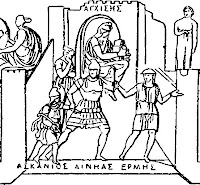 |
| Caroline and fan with animals |
What do I mean by the cities of Hercules? I mean Herculaneum – traditionally founded by the hero Hercules – and Pompeii, named after a big procession (pompa) mounted by the same hero to celebrate his capture of the Cattle of Geryon.
Because Hercules is linked with both Herculaneum and Pompeii, and because all but one of his labours involve animals, I thought it would be fun to link my talk about Animals in Pompeii and Herculaneum with the demi-god himself!
I explained how Hercules, son of Jupiter and a mortal woman, was always causing disasters because of his hot temper and had to atone for his crimes by performing twelve difficult tasks for a king named Eurystheus. The tasks mostly involved producing or killing a monstrous creature. And King Eurystheus mainly jumped in a large jar whenever Hercules appeared with the beast of the day!

By the end of my talk at the British Museum on Monday 27 May 2013, most children and adults in the audience learned all 12 labours (or tasks) of Hercules and also 13 categories of animals in ancient Roman cities.
Romans loved memory tricks, like the Roman House Memory system where you place the objects you want to remember around your house. But here’s the twist: you put those objects there in your imagination.
 |
| teaching the memory-rhyme system |
But don't make your objects dull. Instead of an ordinary brown leather man's shoe, make it a bright red lady's stiletto. Or a day-glo trainer with flashing lights. Or a fur-lined UGG boot.
For objects to be memorable they should be tangible, smellable, tastable, colourful and moving. Funny or bizarre objects also stick in the mind. So do extra large or rude images. Link one of these images with a boring fact and you will never forget it!
Task number two was for Hercules to kill the snake-headed hydra, so we imagined him using a memorable shoe to knock off the hydra’s heads, rather than his club or sword. It seems convoluted but not only does this kind of memory-chain-linking help you remember items on a list backwards, forwards or out of order, but it increases your creativity.
 |
| owl (or two love birds?) mosaic |
Seen as a list (below) it looks pretty dull, but when you are teasing out answers from imaginative kids, using fun illustrations and throwing in gruesome facts like what to do when an owl flies into your house, it is a fun learning experience.
1 = bun = lion = entertaining animals
2 = shoe = hydra = mythological animals
3 = tree = hind (deer) = huntable animals
4 = door = boar = sacrificial animals
5 = hive = stables = working animals
6 = sticks = birds = augury animals
7 = heaven = Cretan bull = sacred/symbolic animals
8 = gate = man-eating mares = transport animals
9 = wine = Amazon’s belt = wearable animals
10 = hen = cattle = edible (food) animals
11 = [pillars of Hercules] = golden apples = protective animals
12 = delve (to dig) = Cerberus = guard animals
 |
| three mosaics of guard dogs |
Guard animals led me to the three famous dog mosaics found in the cities of Hercules and also the famous plaster cast of the space left by a chained dog who could not flee the eruption.
 |
| cast of Pompeian guard dog |
And maybe some of his puppies DID survive and their descendants haunt the ruins of to this day.
When I went to Italy a few months ago I saw a posh city dog near our hotel, and the next day spotted her scruffy country cousin roaming the ruins of Paestum. They could both be descendants of the watchdog from the House of the Tragic Poet in Pompeii (the third dog in the mosaics above).
 |
| descendants of a Pompeian watchdog |
This reminded me of the final category of animals in Pompeii and Herculaneum. Pets!
Yes, then just as today, children and adults loved animals as pets. They loved dogs, birds, even carp, for whom they bought earrings! Perhaps the only animal NOT thought of as a pet that we have today was the cat.
After my talk, while I was signing copies of my Roman Mysteries books, I asked some of the children if they could tell me a random labour of Hercules: number 8, for example, or number 5... Not all of them could do it, but I’ll wager there are a few who will amaze their parents and teachers over the next few days.
Caroline Lawrence writes history-mystery books for children aged 6 and up. For more information visit her website or her Orion Books Author Page. And to see how to make animal noises in Latin, go HERE to download a powerpoint show by kids from Moreton Hall Suffolk for the Minimus Website!



























